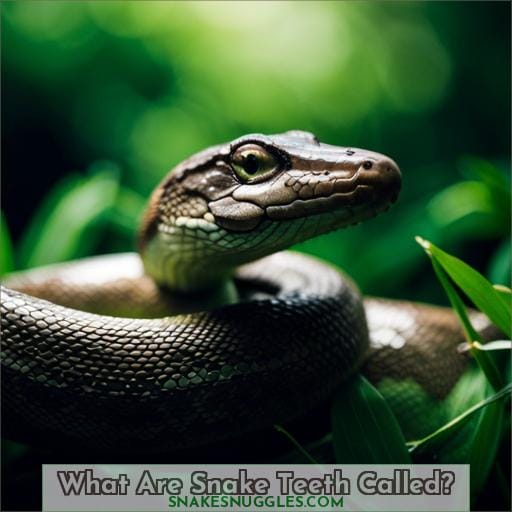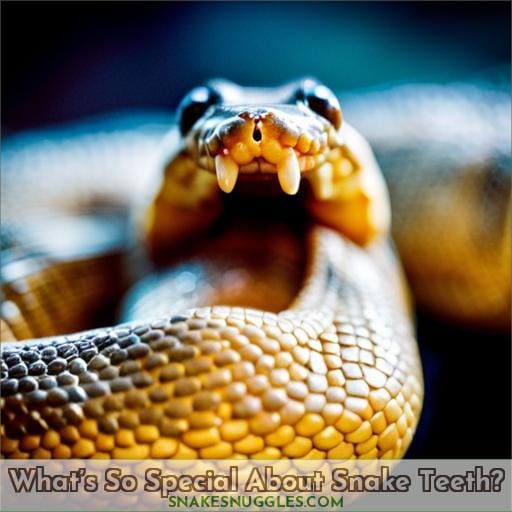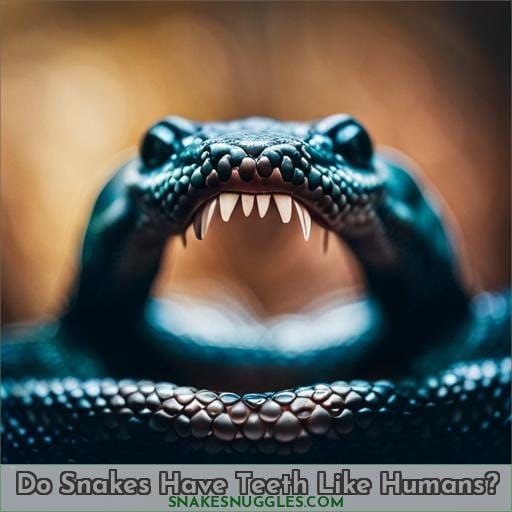This site is supported by our readers. We may earn a commission, at no cost to you, if you purchase through links.
 Do you ever wonder how snakes defend themselves from predators or catch their prey? It may surprise you to learn that the answer lies in their teeth. Yes, snakes have teeth! But not all of them possess fangs like those found on venomous species.
Do you ever wonder how snakes defend themselves from predators or catch their prey? It may surprise you to learn that the answer lies in their teeth. Yes, snakes have teeth! But not all of them possess fangs like those found on venomous species.
Here we will explore what makes snake’s mouths so fascinating and unique as well as answer burning questions such as “what kind of teeth do they have?” “How many rows can be found in a single mouth?” and more.
So open your mind wide; it’s time for an exploration into the mysterious world inside a serpent’s maw…
Table Of Contents
- Key Takeaways
- What Are Snake Teeth Called?
- What’s So Special About Snake Teeth?
- Do All Snakes Have Teeth?
- Can Snakes Unhinge Their Jaws?
- Do Snakes Have Teeth Like Humans?
- How Many Teeth Do Snakes Have?
- What Kind of Teeth Do Snakes Have?
- Do Snakes Lose Their Teeth?
- Do Snakes Have Teeth That Are Hollow?
- Different Rows of Teeth
- Some Snake Species Don’t Possess Teeth
- Frequently Asked Questions (FAQs)
- Conclusion
Key Takeaways
- Snakes have different types of teeth: aglyphous, solenoglyphous, proteroglyphous, and opisthoglyphous.
- Snake teeth come in various sizes and shapes depending on the species.
- Venomous snakes have hollow fangs or grooves to guide venom into prey, while nonvenomous snakes have solid teeth that face backward for a better grip on food items, particularly those featuring venomous snake fangs
.
- Snake tooth replacement cycles vary depending on the species and diet.
What Are Snake Teeth Called?
You may be familiar with the four types of dentition that snakes possess: aglyphous, solenoglyphous, proteroglyphous, and opisthoglyphous. Each type provides a specific advantage to these reptiles in terms of gripping food and delivering venom.
Snakes have teeth that come in various sizes and shapes depending on their species.
For example, vipers have large retractable fangs used for injecting venom, while elapids feature smaller front-fanged teeth designed for potent envenomation. Rear-fanged snakes also sport fangs towards the back of their mouth, whereas egg-eating specialists feature small conical pins adapted to break reptile eggs open without damaging their contents.
Boa constrictors additionally boast sharp curved teeth ideal for holding onto prey when they coil around them before squeezing tightly until death occurs. Green tree pythons take full advantage of numerous jagged points to keep hold captive within canopies, as well as aiding during swallowing afterwards.
Snake dentition provides insights into feeding habits, defensive mechanisms, but most importantly reveals this animal’s unique dental structure enabling it to grow multiple sets throughout its lifetime – something known as polyphyodonts!
What’s So Special About Snake Teeth?
Snakes have a unique type of dentition, with four distinct types of teeth that can be found in their mouths. Aglyphous teeth are the non-fang, sharp and conical-shaped ones located near the front. Solenoglyphous fangs are retractable and contain hollow cavities used to deliver venom.
Proteroglyphous fangs can be found on elapids and measure smaller than solenoglyphs but still deliver powerful venom.
These different variations among snake species give us insight into how they hunt prey, protect themselves from predators, or even break down hardshell eggs for nutrition.
Aglyphous Teeth
Aglyphous teeth are the non-fang teeth present in a snake’s mouth, which help them to hold onto prey and assist with swallowing.
- Tooth arrangement aids in feeding habits.
- Dental variations provide clues about prey manipulation.
- Venomous snake dentition differs from non-venomous species, such as solenoglyphous, proteroglyphous, or opisthoglyphous fangs extending outside of the mouth or located near the back, respectively.
- Tooth placement also varies depending on family and diet needs, allowing maximum grip on food while swallowing it whole without chewing.
Solenoglyphous Teeth
Solenoglyphous teeth are retractable fangs that can deliver venom. This makes them a powerful weapon for prey gripping and feeding habits, as well as defensive mechanisms such as injecting venom into predators.
These types of fangs are found in more advanced snakes like vipers, which have large hollow cavities in their teeth to store the venom before delivery. Snakes replace these teeth multiple times throughout their lifetime due to wear and tear from biting or using them defensively against predators.
As with other snake dentition variations, solenoglyphous teeth provide unique insights into how they evolved over time and adapted to different environments.
Proteroglyphous Teeth
Proteroglyphous teeth are found in elapids, delivering a potent venom that can quickly take down prey. These fangs have grooves and ridges which help guide the venom into its target. Egg-eating snakes don’t possess typical snake teeth but instead have bony projections to break open their food sources.
Proteroglyphous fangs reveal insights about a snake’s feeding habits, defensive mechanisms, and anatomy, as well as provide information regarding the evolution of snakes from lizards with toothed jaws.
Opisthoglyphous Teeth
You possess unique dental structures if you have opisthoglyphous teeth, which are located near the back of your mouth.
- Opisthoglyphous fangs deliver venom.
- They are backward-facing to grasp prey when swallowing.
- They are replaceable as polyphyodont reptiles.
- They have varied dentition like egg eaters or venomous types.
Snakes with these rear fangs showcase specialized adaptations for hunting and defense.
Do All Snakes Have Teeth?
The answer to whether all snakes have teeth is a resounding yes. All snake species possess some form of dentition, though the number and arrangement vary depending on their diet and family.
For example, venomous vipers use large retractable fangs for injecting venom into prey, while elapids have smaller front-facing fangs that they use to deliver potent venom from specialized glands in their mouths.
Rear-fanged snakes also possess modified teeth at the back of their mouth used to inject milder toxins than those found in more dangerous serpents.
Egg-eating snakes lack conventional teeth but instead feature bony projections along the roof of their throat, which they use to break open reptile eggs with ease.
Can Snakes Unhinge Their Jaws?
No, snakes cannot unhinge their jaws, but they do have flexible ones that allow them to consume large prey.
For example, venomous snakes like vipers have large retractable fangs for injecting venom, while elapids possess smaller fangs near the front of their mouth. Rear-fanged snakes also exist, with teeth located towards the back of their mouths.
Boa constrictors and green tree pythons both boast specialized teeth for gripping onto prey as they coil around it or climb in canopies, respectively, to swallow food whole without chewing. Egg-eating snake species are equipped with small dentition due to relying solely on reptile eggs as a source of nutrition.
Snakes are polyphyodonts, which means multiple sets of new teeth will grow throughout their lifetime when required. The arrangement and number depend largely on family characteristics as well as feeding habits.
Even though these creatures lack the ability to unhinge jaws, jaw flexibility is key in allowing them to take down sizable meals – something humans cannot even approach!
Do Snakes Have Teeth Like Humans?
Yes, snakes have teeth, but not like the ones found in humans. In fact, some species of snakes can have up to 200 teeth – over three times as many! Snakes rely on their sharp and conical tooth structure for gripping and swallowing prey.
They are polyphyodonts, which means they continuously replace their set of multiple rows of teeth throughout their lifetime. Depending on the snake’s family and diet habits, there are four types of dentition seen in snakes: aglyphous with non-fang sharp pointed backward-facing teeth; solenoglyphous with retractable fangs that deliver venom; proteroglyphous smaller fangs located at the front end; opisthoglyphous having larger hollow or ridged fangs near the back end used for venom delivery too.
Egg-eating species possess fewer small-sized jagged-edged tooled teeth, while boa constrictors use theirs to grip prey tightly when constricting them using muscular power instead.
How Many Teeth Do Snakes Have?
You’ll be amazed by the variety of teeth that snakes can have, ranging from under a hundred to nearly three hundred! The arrangement and number of snake teeth depend on their family and feeding habits.
Venomous snakes have fangs for venom delivery, while non-venomous species possess solid, conical-shaped teeth. Some vipers even boast large retractable fangs, while elapids usually have smaller ones at the front of their mouths.
Snakes also use their sharpened dentition to manipulate prey during digestion. However, they’re unable to unhinge jaws like humans do.
Egg-eating species are equipped with small but jaggedly pointed pearly whites designed for piercing through tough shells. This allows them access inside without breaking apart its contents before consumption occurs.
Polyphyodonts continuously replace multiple sets throughout life thanks to an adapted dental structure unique among reptiles.
What Kind of Teeth Do Snakes Have?
Snakes are an ancient species, belonging to the reptilian order Squamata. They have a unique set of teeth that vary in number and type depending on their dietary preferences.
Most snakes possess around one hundred small interlocking teeth, but some can have up to three hundred. The arrangement and shape of these teeth depend on the family they belong to, as well as their feeding habits.
For example, boa constrictors have sharp, curved fangs for gripping prey, while green tree pythons feature numerous jagged molars designed specifically for holding onto branches in the canopy above them.
As polyphyodonts, snakes can replace multiple sets of teeth throughout their lifetime, which helps ensure they always have suitable dentition regardless of diet or age. Venomous snake species like vipers typically possess large, retractable hollow fangs, whereas elapids tend towards smaller proteroglyphous fangs at the front end with venom delivery ridges or grooves etched into them instead.
Egg-eating snakes don’t really need any specialized dental features since they swallow eggs whole. So, they usually just make do with fewer regular aglyphous replacement teeth than usual, alongside those longer posterior opisthoglyphic ones located near back corners inside its mouth cavity too.
Do Snakes Lose Their Teeth?
Yes, snakes do lose their teeth over time. However, thanks to their polyphyodont nature, they are able to continuously replace them with new ones! Here’s what you need to know about snake tooth replacement cycles:
- Toothless species like the egg-eating snake have developed bony projections within the throat for breaking open eggs.
- Sharks and other carnivorous fish also have multiple rows of interchanging teeth, which allows them to maximize grip on prey.
- Venomous snakes possess hollow fangs or ridges along their venom delivery pathways, allowing for a more precise injection into their victim’s body.
-
Green tree pythons specialize in eating reptiles and rodents living up high in trees. Therefore, they have numerous jagged teeth adapted specifically for gripping onto these animals while constricting around them securely.
They do not let go until death occurs due to proper care being taken to ensure the animal is dead before release.
Snakes requiring different diets will often require different types of dentition accordingly. This leads us down a path where every single species can be identified simply by examining the type of dentition and its placement throughout the mouth cavity itself.
The ability for certain snake species to have specialized needs regarding feeding requirements should never be overlooked. It helps us understand how truly unique each individual species is compared to others found in the same family genus.
This creates an even better appreciation for Mother Nature’s natural selection process within the wild kingdom ecosystem. It is important to keep all things equal and valid under any circumstances. This process is still ongoing, moving forward appropriately and conclusively.
Do Snakes Have Teeth That Are Hollow?
While some snake species lack teeth altogether, the vast majority have them. In fact, many snakes possess up to three hundred individual teeth! Even fangless species like pythons and boas still have small vestigial teeth located at the back of their mouths.
Venomous snakes use their hollow fangs in combination with a venom pouch to deliver potent bites. It’s believed that these specialized adaptations evolved over time to allow predators such as snakes an evolutionary advantage when hunting prey.
However, not all snake dentition is created equal. Toothless vipers rely on strong muscles for constriction rather than sharp incisors for gripping or tearing flesh.
Ultimately, no matter what type of dentition they may have (or lack thereof), it’s clear that each and every one contributes towards making these fascinating creatures incredibly successful predators in nature today!
Different Rows of Teeth
You have probably heard of snake fangs, but did you know that snakes typically have multiple rows of teeth? Snakes use their teeth for a variety of purposes depending on the species. There are four main types: aglyphous (non-fang), solenoglyphous (retractable fangs), proteroglyphous (smaller front-facing venom delivery system), and opisthoglyphous (venom located at the back).
Depending on diet and family, tooth placement varies from under 100 to up to 200. For example, boa constrictors grip prey with their sharp curved teeth, while green tree pythons hold onto branches in canopies with jagged ones.
Some snakes specialize in eating reptile eggs and possess adapted tooth structures for this purpose.
Venom is delivered by propellant action through hollow or ridged snake fangs – vipers having larger retractable varieties compared to smaller elapids, which deliver potent venom via small grooves within the mouth’s front area.
Rear-fanged snakes also exist – they too depend upon dental structure for successful hunting tactics as well as aid during the digestion process. These species rely mainly upon muscular strength when consuming food items due to their entire swallowing nature, rather than chewing ability like humans do.
Snake dentition provides insights into feeding habits, defensive mechanisms, and general biology, allowing us to have a better understanding of these fascinating creatures!
Some Snake Species Don’t Possess Teeth
Certain species of snakes, like the egg-eating snake, lack teeth. Instead, they possess bony projections in their throat to break open eggs. These adaptations are an example of how a wide variety of dental structures exist in different snake species.
While most snakes have around one hundred small teeth, some can have up to three hundred with varying sizes and shapes based on their diet and lifestyle. For instance, venomous snakes often feature hollow fangs or grooves, which help guide the venom into prey.
On the other hand, nonvenomous types typically consist solely of solid teeth that face backwards for a better grip on food items as they are swallowed whole without chewing.
Furthermore, many snake species also have multiple rows filled with sharp, conical-shaped pieces. These enable them to hold onto struggling prey more easily during the constriction or ingestion process.
With all these variations between different kinds and families within this reptilian group, it further emphasizes just how complex their overall dental structure really is. This is despite not having what we would consider ‘traditional’ tooth characteristics found in other animals, such as mammals.
Frequently Asked Questions (FAQs)
What Types of Teeth Do Snakes Have?
Snakes have four types of teeth: aglyphous, solenoglyphous, proteroglyphous, and opisthoglyphous. Vipers can possess up to 200 fangs; however, the average number is closer to Fangs are used for gripping prey and injecting venom, while smaller functional teeth help with swallowing food whole.
Do Different Snake Species Have Different Types of Teeth?
Yes, different snake species have varying types of teeth. For example, vipers possess large retractable fangs, while elapids feature smaller fangs at the front of their mouth. Meanwhile, rear-fanged snakes exhibit their teeth towards the back, and egg-eating varieties sport adapted dentition to facilitate consuming eggs.
How Do Snake Teeth Evolve Over Time?
Snakes’ teeth are constantly changing and evolving over time. From sharp aglyphous fangs to small proteroglyphous ones, each species has adapted their dentition according to their diet and environment.
Venom-filled solenoglyphous fangs have also evolved in certain snakes, whereas others rely on opisthoglyphs for gripping onto prey as they swallow it whole.
How Do Snake Teeth Help Snakes Hunt and Eat?
Snakes rely on their sharp, conical teeth to grasp and manipulate prey while they swallow it whole. With multiple rows of teeth that can be quickly replaced, snakes maximize their grip and easily digest bones and other hard materials.
Venomous snake species have evolved hollow fangs for venom delivery as part of their defensive mechanisms.
What Is the Largest Number of Teeth Found in a Snake?
Have you ever wondered what the largest number of teeth found in a snake is? It may surprise you to know that some snakes have up to 200 teeth! The arrangement and amount depend on the species, with egg-eating snakes having fewer while fanged vipers boasting more.
Their sharp, conical shape helps them hold onto prey and assists with swallowing.
Conclusion
It’s truly amazing how fascinating and unique snakes can be! From their retractable fangs to their multiple rows of teeth, snakes boast a remarkable set of chompers that make them stand out from other animals.
They can have up to three hundred teeth and four different types of teeth, depending on the species. And despite not being able to unhinge their jaws like us humans, snakes can still use their teeth to grasp and manipulate their prey while swallowing.














